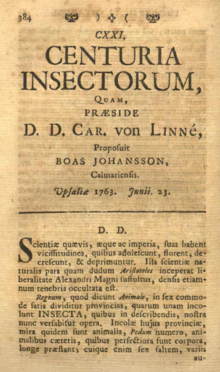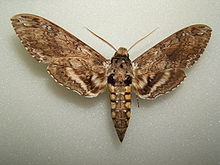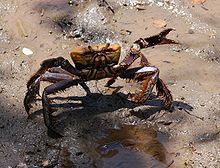- Centuria Insectorum
-
Centuria Insectorum (Latin, "one hundred insects") is a 1763 taxonomic work by Carl Linnaeus, and defended as a thesis by Boas Johansson; which of the two men should be credited with its authorship has been the subject of some controversy. It includes descriptions of 102 new insect and crustacean species that had been sent to Linnaeus from British America, Suriname, Java and other locations. Most of the new names included in Centuria Insectorum are still in use, although a few have been sunk into synonymy, and one was the result of a hoax: a Common Brimstone butterfly with spots painted on was described as the new "species" Papilio ecclipsis.
Contents
Publications
The contents of the work were published twice, under two slightly different titles. Centuria Insectorum Rariorum ("one hundred rare insects") was published as a standalone thesis, while Centuria Insectorum was published as part of Linnaeus' series of Amoenitates Academicæ ("academic delights"). Both bear the date June 23, 1763, although the latter was printed later, in September 1763.[1]
Authorship
 Carl Linnaeus, the probable author of Centuria Insectorum
Carl Linnaeus, the probable author of Centuria Insectorum
Since Centuria Insectorum Rariorum was a thesis presented and defended by one of Linnaeus' students, Boas Johansson (1742–1809) from Kalmar, it has been argued that authorship of the taxa named in it should be assigned to Johansson. The authorship, however, has been the subject of some controversy.[1]
Several lines of argument have been used to suggest that Linnaeus should be considered the author. The role of the person defending the thesis at Swedish universities at the time was to prove his command of Latin, and responsibility for the text of the thesis rested mainly, if not entirely, with the professor.[1] Linnaeus appeared to consider himself the author, referring in his later works to Amoenitates Academicæ without including an abbreviation for the author, as he did for works written by other people.[1] Works presented by students of other taxonomists of the era (such as Carl Peter Thunberg, Adam Afzelius and Elias Magnus Fries) are generally credited to their supervisors, and not the students themselves.[1] Finally, most zoologists, and "Scandinavian authorities on Linnaeana" consider Linnaeus the author;[1] in the interests of nomenclatural stability, it is preferable to continue doing so. The issue was raised in a petition to the International Commission on Zoological Nomenclature and, although a large majority voted in favour of recognising Linnaeus as the author, the one dissenting vote caused the commission to defer its decision.[2]
Sources
The specimens used by Linnaeus or Johansson in writing Centuria Insectorum include some provided by Dr Alexander Garden, a horticulturist from Charles Town in the Province of South Carolina,[3] by Carl Gustav Dahlberg in Suriname,[4] by Hans Johan Nordgren in Java,[5] and from the collection of Baron Charles De Geer from the Province of Pennsylvania.
Contents
The dissertation begins by discussing improvements that the Linnaean system of taxonomy has brought to the study of insects, before describing the new species.[6]
Brimstone hoax
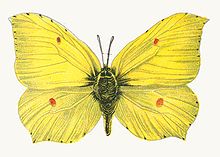 Gonepteryx rhamni: a specimen with spots added was named Papilio ecclipsis in Centuria Insectorum
Gonepteryx rhamni: a specimen with spots added was named Papilio ecclipsis in Centuria Insectorum
One of the species described in Centuria Insectorum was "Papilio ecclipsis". This was based on a specimen sent by William Charlton to James Petiver in 1702, who wrote: "It exactly resembles our English Brimstone Butterfly (R. Rhamni), were it not for those black spots and apparent blue moons on the lower wings. This is the only one I have seen."[7] Carl Linnaeus examined the butterfly, and named it Papilio ecclipsis in Centuria Insectorum Rariorum, including in his Systema Naturae from the 12th edition (1767) onwards.[7] It was not until 1793 that the hoax was discovered by Johan Christian Fabricius, who recognised that the dark patches had been painted on, and that the specimen was a common Brimstone butterfly (now called Gonepteryx rhamni). Although the curator at the British Museum "indignantly stamped the specimen to pieces" when he found out, William Jones created two replicas to replace the lost specimen.[7]
Species
The 102 species described in Centuria Insectorum were divided into seven sections, broadly corresponding with modern insect orders. Exceptions are that thrips (Thysanoptera), mantises (Mantodea) and Orthoptera were included in the Hemiptera, dragonflies (Odonata) were included in the Neuroptera, and the section called "Aptera" contains crustaceans rather than insects in the modern sense. Most of the names introduced in Centuria Insectorum are still in use, albeit in different genera; in a few cases, it is not clear what animal the name refers to.[Note 1]
Coleoptera
 Lucanus capreolus, named in Centuria Insectorum as Scarabæus capreolus
Lucanus capreolus, named in Centuria Insectorum as Scarabæus capreolus
No. Name in Centuria... Status Current name 1 SCARABÆUS Tityus valid [8] Dynastes tityus 2 SCARABÆUS Molosſus [Note 2] valid [9] Catharsius molossus 3 SCARABÆUS ſurinamus synonym [10] Rutela lineola 4 SCARABÆUS capreolus valid [11] Lucanus capreolus 5 DERMESTES Gleditſiæ valid [12] Caryobruchus gleditsiae 6 DERMESTES bactris valid [13] Pachymerus bactris 7 CASSIDA ſpinifex valid [14] Acromis spinifex 8 CASSIDA bipuſtulata junior synonym [15] Stolas discoides 9 CASSIDA bicornis valid [16] Omocerus bicornis 10 CASSIDA leucophæa 11 COCCINELLA ſangvinea valid [17] Cycloneda sanguinea 12 COCCINELLA ſurinamenſis junior synonym [18] Aegithus clavicornis 13 CHRYSOMELA gibboſa valid [19] Gibbifer gibbosus 14 CHRYSOMELA undulata valid [20] Phyllocharis undulata 15 CHRYSOMELA caſtanea 16 CHRYSOMELA Gorteriæ valid [21] Cryptocephalus gorteriae 17 CHRYSOMELA octopunctata 18 CHRYSOMELA punctatiſſima 19 CURCULIO oryza valid [22] Sitophilus oryzae 20 CURCULIO ſurinamenſis valid [22] Curculio surinamensis 21 CANTHARIS bicolor valid [23][Note 3] Thonalmus bicolor 22 CICINDELA æquinoctialis valid [25] Pheropsophus aequinoctialis 23 CICINDELA carolina valid [26] Megacephala carolina 24 ELATER ligneus valid [27] Semiotus ligneus 25 MELOE Chryſomeloides valid [28] Nemognatha chrysomeloides 26 TENEBRIO Gigas [Note 4] Hemiptera
 Stagmomantis carolina, named in Centuria Insectorum as Gryllus carolinus
Stagmomantis carolina, named in Centuria Insectorum as Gryllus carolinus
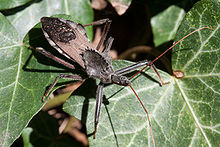 Arilus cristatus, named in Centuria Insectorum as Cimex cristatus
Arilus cristatus, named in Centuria Insectorum as Cimex cristatus
No. Name in Centuria... Status Current name 27 GRYLLUS unicornis [Note 5] synonym [1][30] Empusa pennicornis 28 GRYLLUS carolinus valid [1] Stagmomantis carolina 29 GRYLLUS irroratus synonym [1] Stagmomantis carolina 30 GRYLLUS Lunus valid [1] Monachidium lunum 31 GRYLLUS Cinerarius synonym [1] Pterochroza ocellata 32 GRYLLUS brachypterus /
GRYLLUS necydaloides [Note 6]valid /
junior synonym [31]Pseudophasma brachypterum 33 GRYLLUS javanus junior synonym [1][32] Mecopoda elongata 34 GRYLLUS perſpicillatus valid [1] Ommatolampis perspicillata 35 GRYLLUS ſpinuloſus valid [1] Eugaster spinulosa 36 GRYLLUS ſuccinctus valid [1][33] Nomadacris succincta 37 GRYLLUS brevicornis valid [1] Metaleptea brevicornis 38 GRYLLUS convolutus valid [1] Miogryllus convolutus 39 CICADA flammea valid [34] Zanna flammea 40 CICADA truncata valid [34] Oryxa truncata 41 CIMEX ictericus valid [35] Euschistus ictericus 42 CIMEX criſtatus valid [36] Arilus cristatus 43 CIMEX ſcaber valid [37] Acanthocoris scaber 44 CIMEX ſuccinctus valid [36] Largus succinctus 45 CIMEX hæmorrhous valid [38] Leptoscelis haemorrhous 46 CIMEX nobilis valid [39] Calliphara nobilis 47 COCCUS capenſis valid [40] Conchaspis capensis 48 TRIPS paradoxa valid [41] Thrips paradoxa Lepidoptera
 Amathusia phidippus, named in Centuria Insectorum as Papilio phidippus
Amathusia phidippus, named in Centuria Insectorum as Papilio phidippus
 Anartia jatrophae, named in Centuria Insectorum as Papilio Jatrophæ
Anartia jatrophae, named in Centuria Insectorum as Papilio Jatrophæ
 Argynnis hyperbius, named in Centuria Insectorum as Papilio Hyperbius
Argynnis hyperbius, named in Centuria Insectorum as Papilio Hyperbius Manduca sexta, named in Centuria Insectorum as Sphinx sexta
Manduca sexta, named in Centuria Insectorum as Sphinx sexta
No. Name in Centuria... Status Current name 49 PAPILIO Ægiſthus junior synonym [5][42] Graphium agamemnon 50 PAPILIO Polydorus valid [5][42] Atrophaneura polydorus 51 PAPILIO Orontes valid [5] Alcides orontes 52 PAPILIO Phidippus valid [5][42] Amathusia phidippus 53 PAPILIO Medon valid [5] Euphaedra medon 54 PAPILIO Mneme valid [5] Melinaea mneme 55 PAPILIO Ædea valid [5] Eterusia aedea 56 PAPILIO Melite valid [43] Enantia melite 57 PAPILIO Scylla valid [5][42] Catopsilia scylla 58 PAPILIO Polybe valid [5] Atlides polybe 59 PAPILIO Philea valid [5] Phoebis philea 60 PAPILIO Philomela valid [5][42] Ypthima philomela 61 PAPILIO Electo valid [5] Colias electo 62 PAPILIO Helcita valid [5] Aletis helcita 63 PAPILIO Idea valid [5][42] Idea idea 64 PAPILIO Strilidore nomen dubium [5] unknown 65 PAPILIO Eurydice valid [5] Satyrodes eurydice 66 PAPILIO Demophile valid [5] Itaballia demophile 67 PAPILIO ecclipſis hoax[7] Gonepteryx rhamni 68 PAPILIO Canace valid [5] Kaniska canace 69 PAPILIO Hypermneſtra valid [5][42] Elymnias hypermnestra 70 PAPILIO Talaus junior synonym [5] Entheus priassus 71 PAPILIO Ariadne valid [5][42] Ariadne ariadne 72 PAPILIO Atlites valid [5] Junonia atlites 73 PAPILIO Jatrophæ valid [5] Anartia jatrophae 74 PAPILIO Dido valid [5] Philaethria dido 75 PAPILIO Hyperbius valid [5][42] Argynnis hyperbius 76 PAPILIO Cydippe junior homonym; rejected [42][Note 7] Cethosia cydippe 77 PAPILIO Peleus junior synonym [5] Entheus priassus 78 PAPILIO Actorion valid [5] Bia actorion 79 PAPILIO Arcius valid [5] Rhetus arcius 80 PAPILIO Augias valid [5][42] Telicota augias 81 SPHINX ſexta valid [44] Manduca sexta 82 PHALÆNA gangis valid [45] Creatonotos gangis 83 PHALÆNA Phalonia valid [46] Eudocima phalonia 84 PHALÆNA heteroclita nomen dubium [47] Enantia melite? Neuroptera
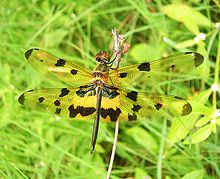 Rhyothemis variegata, named in Centuria Insectorum as Libellula variegata
Rhyothemis variegata, named in Centuria Insectorum as Libellula variegata
No. Name in Centuria... Status Current name 85 LIBELLULA carolina valid [48] Tramea carolina 86 LIBELLULA variegata valid [49] Rhyothemis variegata 87 HEMEROBIUS pectinicornis valid [50] Chauliodes pectinicornis Hymenoptera
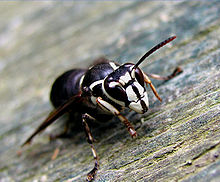 Dolichovespula maculata, named in Centuria Insectorum as Vespa maculata
Dolichovespula maculata, named in Centuria Insectorum as Vespa maculata
No. Name in Centuria... Status Current name 88 SIREX columba valid [51] Tremex columba 89 SPHEX penſylvanica valid [52] Sphex pensylvanicus 90 SPHEX cærulea junior homonym of Sphex caerulea Linnaeus, 1758 (= Entypus caeruleus)[53] Chalybion californicum [52] 91 VESPA maculata valid [54] Dolichovespula maculata 92 VESPA quadridens valid [55] Monobia quadridens 93 VESPA annularis valid [56] Polistes annularis 94 FORMICA binodis [Note 8] junior synonym [57] Tetramorium caespitum Diptera
No. Name in Centuria... Status Current name 95 ASILUS æſtuans valid [58] Efferia aestuans Aptera
No. Name in Centuria... Status Current name 96 CANCER Dormia valid [59] Dromia dormia 97 CANCER Vocans [Note 9] valid [59] Uca vocans 98 CANCER cordatus valid [59] Ucides cordatus 99 CANCER epheliticus valid [59] Hepatus epheliticus 100 CANCER paraſiticus nomen dubium [59] Tumidotheres maculatus? 101 CANCER filiformis nomen dubium [60] Caprella lobata? 102 ONISCUS linearis valid [61] Idotea linearis Further reading
- Carl Linnaeus (1763) (in Latin). Amoenitates Academicæ. Vol. 6. http://www.biodiversitylibrary.org/item/15498.
- Carl Linnaeus (1763) (in Latin) (PDF). Centuria Insectorum Rariorum. http://huntbot.andrew.cmu.edu/HIBD-PDF/LinnaeanDiss/Liden-129.pdf. (also available at Biodiversity Heritage Library, SUB Göttingen and Google Books)
Footnotes
- ^ Linnaeus' orthography has been preserved here as far as possible, including the use of ſ – the long s.
- ^ Scarabæus Molosſus was previously included in the 10th edition of Systema Naturae (1758).
- ^ At least two other species have been named "Cantharis bicolor". Cantharis bicolor Panzer, 1797 is a synonym of Cantharis pallida Goeze, 1777, while Cantharis bicolor Herbst, 1784 is a synonym of Cantharis thoracica (Olivier, 1790).[24]
- ^ Linnaeus later named a species Tenebrio gigas in the 12th edition of Systema Naturae (1767), but corrected it to Tenebrio gages in the erratum.[29] That species is now Blaps gages, which may be synonymous with Blaps kollari Seidlitz.
- ^ Linnaeus later referred to this species as Mantis pectinicornis.[1]
- ^ Appears as "GRYLLUS brachypterus" in Centuria Insectorum Rariorum and as "GRYLLUS necydaloides" in Centuria Insectorum.
- ^ Papilio cydippe Linnaeus, 1763 is a junior homonym of Papilio cydippe Linnaeus, 1761, both of which are rendered invalid by the preservation of Papilio cydippe Linnaeus, 1767.[42]
- ^ Formica binodis Fabricius, 1775 is a different species, now called Messor barbarus.[57]
- ^ Appears as "CANCER Vocaus" in Centuria Insectorum Rariorum; both versions include an autoreference to the 10th edition of Systema Naturae.
References
- ^ a b c d e f g h i j k l m n o p q r Judith A. Marshall (1983). "The orthopteroid insects described by Linnaeus, with notes on the Linnaean collection". Zoological Journal of the Linnean Society 78 (4): 375–396. doi:10.1111/j.1096-3642.1975.tb02266.x.
- ^ R. V. Melville (1973). "Opinion 998. Gryllus Locusta succinctus Linnaeus, 1763 (Insects, Orthoptera): neotype designated under the plenary powers". Bulletin of Zoological Nomenclature 30: 77–79. http://www.biodiversitylibrary.org/item/44472.
- ^ Ray Desmond (1994). "Garden, Alexander (1730–1791)". Dictionary of British and Irish botanists and horticulturists: including plant collectors, flower painters, and garden designers. CRC Press. pp. 269. ISBN 9780850668438. http://books.google.co.uk/books?id=thmPzIltAV8C.
- ^ A. M. Husson (1978). "Introduction". The mammals of Suriname. Issue 2 of Zoölogische monographieën. Brill Publishers. pp. xvii–xxxiv. ISBN 9789004058194. http://books.google.co.uk/books?id=1s8UAAAAIAAJ.
- ^ a b c d e f g h i j k l m n o p q r s t u v w x y z aa ab ac ad Martin R. Honey & Malcolm J. Scoble (2008). "Linnaeus's butterflies (Lepidoptera: Papilionoidea and Hesperioidea)". Zoological Journal of the Linnean Society 132 (3): 277–399. doi:10.1111/j.1096-3642.2001.tb01326.x.
- ^ "The Linnaean Dissertations". Hunt Institute for Botanical Documentation. http://huntbot.andrew.cmu.edu/HIBD/Departments/Library/LinnaeanDiss.shtml. Retrieved June 16, 2010.
- ^ a b c d "The Charlton Brimstone Butterfly". The Museum of Hoaxes. http://www.museumofhoaxes.com/hoax/archive/permalink/the_charlton_brimstone_butterfly/. Retrieved June 16, 2010.
- ^ "Scarabaeidae". Nomina Insecta Nearctica. http://www.nearctica.com/nomina/beetle/colscar.htm. Retrieved June 16, 2010.
- ^ Lars Wallin (February 14, 2001). "Catalogue of type specimens. 4. Linnaean specimens" (PDF). Uppsala University. http://www.evolutionsmuseet.uu.se/samling/UUZM04_Linnaeus.pdf. Retrieved June 16, 2010.
- ^ Jan van der Hoeven (1849). "Rutela Latr." (in Dutch). Handboek der Dierkunde. Vol. 1. Amsterdam: C. G. Sulpke. pp. 595–596. http://books.google.co.uk/books?id=yIo-AAAAcAAJ.
- ^ M. J. Paulsen (September 13, 2006). "Lucanus capreolus (Linnaeus, 1763)". Generic Guide to New World Scarab Beetles. University of Nebraska–Lincoln. http://www.unl.edu/museum/research/entomology/Guide/Scarabaeoidea/Lucanidae/LUC/LUCA/capreolus/capreolus.html. Retrieved June 16, 2010.
- ^ Jan A. Nilsson & Clarence Dan Johnson (1990). "A new species of palm bruchid from Cuba and a redescription of Caryobruchus gleditsiae (L.) (Coleoptera: Bruchidae: Pachymerinae)". The Coleopterists Bulletin 44 (1): 50–59. JSTOR 4008665.
- ^ Joel Hallan. "Chryomelidae Latreille, 1802". Texas A&M University. http://insects.tamu.edu/research/collection/hallan/CHRYSOMRpt1.txt. Retrieved June 16, 2010.
- ^ Caroline S. Chaboo (2001). "Revision and phylogenetic analysis of Acromis Chevrolat (Coleoptera: Chrysomelidae: Cassidinae: Stolaini)". The Coleopterists Bulletin 55 (1): 75–102. doi:10.1649/0010-065X(2001)055[0075:RAPAOA]2.0.CO;2. JSTOR 4009574.
- ^ Leceh Borowiec (1998). "Review of the Cassidinae of Ecuador, with a description of thirteen new species (Coleoptera: Chrysomelidae)" (PDF). Genus 9 (2): 155–246. http://www.biol.uni.wroc.pl/cassidae/borowiececuador.pdf.
- ^ Lech Borowiec & Jolanta Świętojańska. "Genus: Omocerus Chevrolat, 1835". Cassidinae of the world - an interactive manual (Coleoptera: Chrysomelidae). University of Wroclaw. http://www.biol.uni.wroc.pl/cassidae/katalog%20internetowy/omocerus.htm. Retrieved June 16, 2010.
- ^ Martin H. Muma (1955). "Lady beetles (Coccinellidae: Coleoptera) found on Citrus in Florida". The Florida Entomologist 38 (3): 117–124. JSTOR 3492201.
- ^ Paul E. Skelley (2009). "Pleasing fungus beetles of the West Indies (Coleoptera: Erotylidae: Erotylinae)" (PDF). Insecta Mundi 82: 1–94. http://digitalcommons.unl.edu/cgi/viewcontent.cgi?article=1610&context=insectamundi.
- ^ "Erotylidae". Insectos de Nicaragua. http://www.bio-nica.info/Ento/Coleo/EROTYLIDAE.htm. Retrieved June 16, 2010.
- ^ Shinsaku Kimoto & J. L. Gressitt (1981). "Chrysomelidae (Coleoptera) of Thailand, Cambodia, Laos and Vietnam. II. Clytrinae, Cryptocephalinae, Chlamisinae, Lamprosomatine and Chrysomelinae" (PDF). Pacific Insects 23 (3–4): 286–391. http://hbs.bishopmuseum.org/pi/pdf/23%283%29-286.pdf.
- ^ "Coleoptera". Swedish Museum of Natural History. http://www2.nrm.se/en/col_g.html. Retrieved June 16, 2010.
- ^ a b "Electronic Catalogue of Weevil names (Curculionoidea)". http://wtaxa.csic.es/search/basicsearchHP.aspx. Retrieved June 16, 2010.
- ^ Charles W. Leng & Andrew J. Mutchler (1922). "The Lycidæ, Lampyridæ and Cantharidæ (Telephoridæ) of the West Indies". Bulletin of the American Museum of Natural History 46 (8): 413–499. hdl:2246/1301.
- ^ "NBN Taxonomic and Designation Information: Cantharis". NBN Gateway. http://data.nbn.org.uk/speciesInfo/taxonomy.jsp?searchTerm=Cantharis&spKey=NHMSYS0001717476. Retrieved June 17, 2011.
- ^ George E. Ball (1996). "Vignettes of the history of neotropical carabidology" (PDF). Annales Zoologici Fennici 33: 5–16. http://www.sekj.org/PDF/anzf33/anzf33-005p.pdf.
- ^ P. M. Choate (2001). "Manual for the Identification of the Ground Beetles (Coleoptera: Carabidae) (including tiger beetles) of Florida" (PDF). University of Florida. http://entnemdept.ifas.ufl.edu/choate/florida_carabidae.pdf.
- ^ Maria Helena ParreiraI & Sônia A. Casari (2004). "Morphology of three Brazilian species of Semiotus (Coleoptera, Elateridae, Semiotinae)". Iheringia. Zool. 94 (3): 285–294. doi:10.1590/S0073-47212004000300011.
- ^ M. García-París, D. Buckley & G. Parra-Olea (2007). "Catálogo taxonómico-geográfico de los coleópteros de la familia Meloidae de México" (PDF). Graellsia 63 (2): 165–258. http://graellsia.revistas.csic.es/index.php/graellsia/article/download/92/92.
- ^ Francisco Welter Schultes (December 16, 2009). "Species taxon summary: gigas Linné, 1767 described in Tenebrio". AnimalBase. Georg-August-Universität Göttingen. http://www.animalbase.uni-goettingen.de/zooweb/servlet/AnimalBase/home/speciestaxon?id=12424. Retrieved July 14, 2010.
- ^ Joel Hallan. "Empusidae Burmeister, 1838". Texas A&M University. http://insects.tamu.edu/research/collection/hallan/Arthropoda/Insects/Mantodea/Family/Empusidae.txt. Retrieved June 16, 2010.
- ^ P. E. Bragg (1997). "Biographies of Phasmatologists – 5. Carl Linnaeus" (PDF). Phasmid Studies 16 (2): 19–24. http://phasmid-study-group.org/sites/phasmid-study-group.org/files/Bragg1997c.pdf.
- ^ "synonym Gryllus javanus Johannson, 1763". Orthoptera Species File Online. http://orthoptera.speciesfile.org/Common/basic/Taxa.aspx?TaxonNameID=3824. Retrieved June 16, 2010.
- ^ S. Tanakaa & Y. Sadoyama (1997). "Photoperiodic termination of diapause in field-collected adults of the Bombay locust, Nomadacris succincta (Orthoptera: Acrididae) in southern Japan". Bulletin of Entomological Research 67 (87): 533–539. doi:10.1017/S0007485300041407.
- ^ a b Marcelo da Silva Baptista (2006) (PDF). Taxonomic de Fulgoroides no Brasil (Insecta: Hemiptera: Auchenorrhyncha), com ênfase em Dictyopharidae (Doctor Scientiae thesis). Universidade Federal de Viçosa. http://www.tede.ufv.br/tedesimplificado/tde_arquivos/10/TDE-2007-07-11T130754Z-649/Publico/texto%20completo.pdf.
- ^ Daniel E. Perez-Gelabert & Donald B. Thomas (2005). "Stink bugs (Heteroptera: Pentatomidae) of the island of Hispaniola, with seven new species from the Dominican Republic" (PDF). Boletín Sociedad Entomológica Aragonesa 37: 319–352. http://www.careers.ndsu.edu/ndsu/rider/Pentatomoidea/PDFs/P/PerezGelabert_Thomas_2005.pdf.
- ^ a b "Heteroptera List". Nomina Insecta Nearctica. http://www.nearctica.com/nomina/hemips/heterol.htm. Retrieved June 16, 2010.
- ^ Gordon F. Gross (1963). "Insects of Micronesia. Coreidae (Alydini by J. C. Schaffner), Neididae, and Nabidae" (PDF). Proceedings of the Royal Society of Queensland 76: 27–91. http://hbs.bishopmuseum.org/pubs-online/pdf/iom7-7cor.pdf.
- ^ Charles Davies Sherborn (March 1, 1927). "Part XII. Index haani–implicatus". Index Animalium. The Trustees of the British Museum. pp. 2895. http://www.archive.org/details/sil34_02_12.
- ^ C. H. C. Lyal (1979). "A review of the genus Calliphara Germar, 1839 (Hemiptera: Scutellaridae)" (PDF). Zoologische Mededelingen 54 (12): 149–181. http://www.repository.naturalis.nl/document/149195.
- ^ "Conchaspis capensis (Linnaeus)". ScaleNET. Agricultural Research Service. November 4, 2009. http://www.sel.barc.usda.gov/catalogs/conchasp/Conchaspiscapensis.htm. Retrieved June 16, 2010.
- ^ "Species Thrips paradoxa Linnaeus, 1758". Thrips of the World Checklist. CSIRO. http://anic.ento.csiro.au/worldthrips/taxon_details.asp?BiotaID=8279. Retrieved June 16, 2010.
- ^ a b c d e f g h i j k l A. Steven Corbet (1949). "The Linnaean names of Indo-Australian Rhopalocera. Part 7. Summary of determinations". Proceedings of the Royal Entomological Society of London. B 18 (9–10): 191–200.
- ^ E. D. Edwards, J. Newland & L. Regan (2001). "Heliconiinae". Zoological Catalogue of Australia Volume 31.6: Lepidoptera: Hesperioidea, Papilionoidea. CSIRO Publishing. pp. 324–327. ISBN 9780643067004.
- ^ "Manduca sexta". Crop Protection Compendium. CAB International. 2007. http://www.cabicompendium.org/NamesLists/CPC/Full/PROTSE.htm. Retrieved June 16, 2010.
- ^ "Species Creatonotos gangis (Linnaeus, 1763)". Australian Faunal Directory. Department of the Environment, Water, Heritage and the Arts. March 31, 2010. http://www.environment.gov.au/biodiversity/abrs/online-resources/fauna/afd/taxa/300dbab6-f024-463d-874f-c1215acbaaf3. Retrieved June 16, 2010.
- ^ J. M. Zaspel and M. A. Branham (2008). "World Checklist of Tribe Calpini (Lepidoptera: Noctuidae: Calpinae)" (PDF). Insecta Mundi 47: 1–15. http://www.fsca-dpi.org/insectamundi2008/0047ZaspelandBranham.pdf.
- ^ Markku Savela. "Enantia Hübner, [1819]". Lepidoptera and some other life forms. http://www.funet.fi/pub/sci/bio/life/insecta/lepidoptera/ditrysia/papilionoidea/pieridae/dismorphiinae/enantia/index.html. Retrieved June 16, 2010.
- ^ Ethan Bright (May 21, 2006). "Libellulidae - Skimmers". Aquatic Insects of Michigan. University of Michigan. http://insects.ummz.lsa.umich.edu/~ethanbr/aim/sp/Odonata/sp_oom_libellulidae.html. Retrieved June 16, 2010.
- ^ Martin Schorr, Martin Lindeboom & Dennis Paulson. "Anisoptera". World Odonates. http://bellsouthpwp.net/b/i/billmauffray/fscaanis.htm. Retrieved June 16, 2010.
- ^ "Detailed record for Chauliodes pectinicornis (Linnaeus, 1763)". Essig Museum of Entomology Species Lists. University of California, Berkeley. http://essigdb.berkeley.edu/cgi-bin/eme_species_query?step=detail&seq_num=48727. Retrieved June 16, 2010.
- ^ Woodrow W. Middlekauff (1960). "The siricid wood wasps of California (Hymenoptera: Symphyta)" (PDF). Bulletin of the California Insect Survey 6 (4): 59–78. http://essig.berkeley.edu/documents/cis/cis06_4.pdf.
- ^ a b Richard Mitchell Bohart & Arnold S. Menke (1976). "Subfamily Sphecinae". Sphecid wasps of the world: a generic revision. University of California Press. pp. 79–154. ISBN 9780520023185. http://books.google.co.uk/books?id=FExMjuRhjpIC.
- ^ "Chalybion" (PDF). California Academy of Sciences. November 16, 2010. http://research.calacademy.org/files/Departments/ent/sphecidae/Genera_and_species_pdf/Chalybion.pdf. Retrieved February 8, 2011.
- ^ "Genus Dolichovespula Rohwer". Checklist of the species in the subfamily Vespinae (Insecta: Hymenoptera: Vespidae). November 29, 2005. http://www.ipc.ibaraki.ac.jp/~jkrte/wasp/vespinae/Dolicho.html. Retrieved June 16, 2010.
- ^ J. van der Vecht & James M. Carpenter (1990). "A catalogue of the genera of the Vespidae (Hymenoptera)" (PDF). Zoologische Verhandelingen 260: 1–62. http://www.repository.naturalis.nl/document/148842.
- ^ James M. Carpenter. "Subgenus Gyrostoma Latreille". Distributional Checklist of the species of the genus Polistes (Hymenoptera: Vespidae: Polistinae: Polistini). http://www.ipc.ibaraki.ac.jp/~jkrte/wasp/polistes/Polistes.htm. Retrieved June 16, 2010.
- ^ a b "Formica binodis". Hymenoptera Name Server version 1.5. December 19, 2007. http://osuc.biosci.ohio-state.edu/hymDB/nomenclator.name_entry?text_entry=Formica+binodis. Retrieved June 16, 2010.
- ^ "Asilus aestuans Linnaeus, 1763". Integrated Taxonomic Information System. http://www.itis.gov/servlet/SingleRpt/SingleRpt?search_topic=TSN&search_value=133507.
- ^ a b c d e Peter K. L. Ng, Danièle Guinot & Peter J. F. Davie (2008). "Systema Brachyurorum: Part I. An annotated checklist of extant Brachyuran crabs of the world" (PDF). Raffles Bulletin of Zoology 17: 1–286. http://rmbr.nus.edu.sg/rbz/biblio/s17/s17rbz.pdf.
- ^ Thomas Roscoe Rede Stebbing (1888). Report on the Amphipoda collected by H.M.S. Challenger during the Years 1873–76. Report on the scientific results of the voyage of H.M.S. Challenger during the years 1873–76 : under the command of Captain George S. Nares, R.N., F.R.S. and Captain Frank Turle Thomson, R.N. (1888). pp. 29–30. http://www.archive.org/details/reportonscientif18882901grea.
- ^ G. Poore & M. Schotte (2009). "Idotea linearis (Linnaeus, 1766)". In M. Schotte, C. B. Boyko, N. L. Bruce, G. C. B. Poore, S. Taiti & G. D. F. Wilson. World Marine, Freshwater and Terrestrial Isopod Crustaceans database. World Register of Marine Species. http://www.marinespecies.org/aphia.php?p=taxdetails&id=119046. Retrieved June 16, 2010.
Categories:- 1763 books
- 1763 in science
- Carl Linnaeus
Wikimedia Foundation. 2010.

